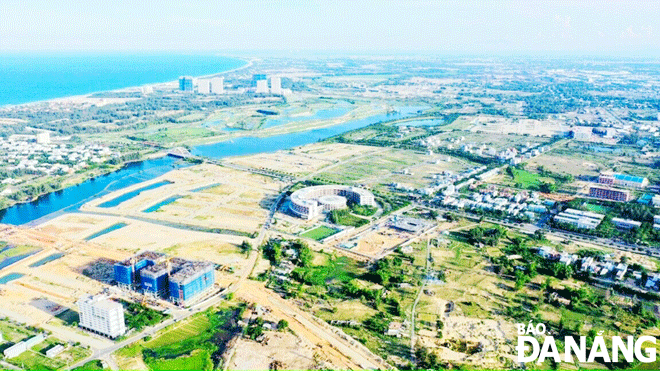Creating new ecosystem from the zone planning of innovation urban subdivision
The Singapore-headquartered CPG Consultants company has just proposed the zone planning idea for ‘innovation urban subdivision’ which is one of 12 sub-divisions mentioned in the Da Nang Master Plan for its major by 2030, with a vision towards 2045.
 |
| The FPT urban area in Ngu Hanh Son District will become an innovation urban area in the southeast of the city. Photo: NAM PHUONG |
The ‘Innovation urban subdivision’ is bounded by the National Highway 14B to the north, Da Nang - Quang Ngai expressway and national highway 1A to the west, Vo Chi Cong Street and Dong No area to the east, and Quang Nam Province to the south.
Covering an area of 3,903ha, the subdivision will encompass Ngu Hanh Son District’s Hoa Quy Ward; the wards of Hoa Xuan, Hoa Tho Dong, Hoa Tho Tay and Khue Trung in Cam Le District; and the Hoa Chau and Hoa Phuoc communes of Hoa Vang District. The site’s population size is expected to be about 233,000 people.
The intention of the zone planning of this subdivision is to develop high-quality education and training, healthcare, and sports services. The size will boast such landmarks as the Da Nang university urban area, innovation centres, software parks and international hospitals, the Hoa Xuan sports complex, and the Southern Coach Station.
The subdivision will be characterized by medium-sized buildings that blend seamlessly natural landscapes in a bid to create an innovative environment.
The context for the development planning of the innovation urban subdivision is defined by the subdivision as one of four employment clusters that integrate economic activities and city functions connected by the "innovation belt" and “high-tech agricultural belt”. This will be an opportunity to create many jobs in the fields of science and technology for local habitants, as well as attract a large amount of domestic and foreign investment inflows and high-quality workforce with the goal of developing the applied research, education, treatment and healthcare sectors.
The spotlight of this subdivision will be the development of the FPT urban area, the Da Nang University Village urban area, specifically the existing educational - training functional clusters.
In the near future, appeals will be made for investments into smart infrastructure in order to develop creative spaces and startup ecosystems for businesses. From the foundation of urban infrastructure, innovation and creativity in smart infrastructure will offer businesses the opportunities to create closer links and expand development cooperation across all economic fields.
The development strategy and vision of the ‘innovation urban subdivision’ is to create a new ecosystem that will comprise a knowledge ecosystem, an innovation ecosystem, a gateway ecosystem, and a creative industry ecosystem.
In the idea of planning the spatial organisation of the innovation urban subdivision, there will be 4 sub-zones or 8 sub-zones with separate but homogeneous properties that complement each other on an ecosystem along the innovation corridor. On the innovation corridor, every resident will be served by a community service center.
Accordingly, every 500m, there will be utilities serving the community every day such as shops, kindergartens, amusement parks, etc. Meanwhile, every 1.5km, there will be a co-working space and an event space.
In the sub-zones of the innovation urban subdivision, residential areas with high population density will be formed in university urban and gateway areas so as to attract and train talents for the innovation ecosystem. In order to realize this goal, the innovation urban subdivision must ensure the harmony between work, accommodation, and daily life.
Specifically, the importance will be attached to providing the ideal accommodation for a high-quality workforce, offering high-standard social infrastructure for present and future generations, and creating a network of recreational spaces for exchange and team building activities, and skill development.
Residents in the innovative urban subdivision will work and live with the motto of ‘every day here will be an experience of a memorable business or vacation trip’.
Appealing for investment into social infrastructure is considered a decisive factor for the development of innovation community here. In particular, symbolic mixed-use blocks will be developed in the gateway sub-zone in order to create the entrance mark of the innovation urban subdivision, whilst the innovation industry ecosystem will be formed in the innovation centre area.
Reporting by NAM PHUONG - Translating by M.D